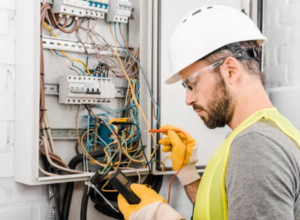Best Electrician Huntsville installs, maintains, and repairs electrical power, lighting, and control systems in homes, businesses, and factories. It’s a demanding career that requires skill and precision.

While no one enjoys a power outage, it’s important to know what causes them so that you can keep your family safe. A power outage occurs when a region’s electrical grid suffers damage, interrupting electricity flow to homes. This may be due to a natural disaster, such as a tornado or hurricane, or it can occur because of an accident, such as a truck driving into a power line or trees falling across wires. It’s also possible for a power outage to happen because of a fault on the transmission lines that carry electricity between utility companies and homes.
Occasionally, utility companies schedule planned outages to conduct maintenance and upgrades on their equipment. They will usually let customers know ahead of time when an outage will occur so that they can plan accordingly.
If you lose power, it’s a good idea to stay inside and close all doors and windows. This will help keep any intruders from entering your home, and it’s also a good idea to unplug any non-essential electronics that could surge when the power comes back on.
It’s also a good idea to check outside to see if other homes in your neighborhood are experiencing a power outage, too. If you lose power and your neighbors do, this could indicate a larger problem with your local grid. Also, be aware that a loss of power can cause carbon monoxide poisoning. If this happens, call emergency services immediately.
Flickering Lights or Outlets
If you’re experiencing flickering lights or outlets in your home, it’s definitely time to call in an emergency electrician. These types of electrical quirks can be signs of serious concerns like loose wiring, power surges, or an electrical circuit overload that could lead to electric shock or house fires. In the worst case scenario, you’ll need to turn off your power at the circuit breaker until the problem is resolved.
If the flickering occurs in just one room or outlet, it may be caused by a loose wire connection that only affects that specific fixture or light switch. This can be a quick and easy fix for an electrician, but it’s still important to have a licensed professional take a look at the issue to make sure everything is safe.
Flickering lights or outlets in multiple rooms or on all devices at the same time could be a sign of a larger problem with your home’s electrical system. Homes with older wiring or those in areas with unstable power supplies often experience fluctuations that can cause flickering lights and other issues in your home. An electrician can evaluate your home’s wiring and recommend any necessary upgrades to ensure safety and reliability.
If you’re seeing these symptoms, it’s best to contact an electrician immediately. They’ll be able to assess the problem and provide the fastest, safest solution. They’ll also have the tools and experience to handle any problems, from outdated wiring to power spikes that can cause a fire.
Heat-Generating Appliances
Appliances consume a significant portion of global energy, emitting GHGs through direct combustion and indirect electricity generation. They also power a multitude of other essential services, such as cooling and lighting homes and offices, communicating between people and businesses, saving labor, contributing to livelihoods and wellbeing, and powering industrial processes across scales.
Faulty appliances can cause fire hazards, especially those that produce heat. If these devices overheat due to prolonged use, faulty thermostats, blocked ventilation, or insufficient airflow, they may ignite nearby materials and cause a house fire. Overheating can also be caused by a short circuit, overloaded electrical outlets, or old or damaged wiring.
To prevent this, it’s important to use ENERGY STAR rated appliances and never plug more than one heat-producing appliance into an outlet at a time. It’s also a good idea to only run such appliances in the evening when temperatures are cooler.
Additionally, it’s a good idea to have your home’s wiring examined periodically by an electrician. Faulty wires or improper installations can lead to a variety of problems, including blowing fuses and tripping circuit breakers. A tingling sensation when you touch a plug or switch is another common sign of trouble. Finally, make sure that only major appliances like refrigerators, dryers, or washers are plugged into receptacle outlets and not extension cords. If you notice any of these issues, it’s a good idea to call emergency electrical services as soon as possible.
Extension Cords
Extension cords can make it easy to power appliances and equipment, but if you use them incorrectly they can cause overheating, electrical fires or even death. Generally, you should only use extension cords on a temporary basis and only when they are necessary. When you do, only use cords that are rated for indoor or outdoor use and have a UL (Underwriters Laboratories) or ETL (Electrical Testing Laboratory) label on them.
You should also keep in mind that extension cords have a limited capacity for current, which is known as amperage. The longer a cord is, the lower the amperage it can carry. Using an extension cord that is too light for the power requirements of the device you’re plugging in can cause the cord to overheat, which may melt or create a spark.
If a cord is damaged, you should stop using it immediately and call an electrician to inspect it. This includes examining the cord for signs of heat or fire damage, such as blackened or missing plug prongs, exposed wires from cuts, abrasion or gnawing children or pets, and plugs that separate from the cord.
You should also only use cords in a well-lit area. Never run them under rugs or in doorways, where they can become trip hazards or get hit by traffic or furniture. If you need more outlets where you’re using extension cords, you should have a licensed electrician install them in that location.
Unusual Noises
When you hear unusual sounds coming from your home electrical system, it’s important to pay attention. Some noises may signal a harmless, but others require emergency electrical services from an electrician. Humming and buzzing sounds are normal, as they’re a result of the flow of electricity through wires in your appliances. However, if the sound becomes louder and more metallic, you’ll want to call an electrician.
Hissing sounds are another common electrical problem that can be a sign of a loose wire or improperly grounded outlet or appliance. These noises often originate in the breaker box and can be dangerous if you try to fix them on your own. Loose wires can also produce electric arcs, which are discharges of electricity jumping from one wire to the next. These arcs can be deadly and should only be handled by an electrician.
Other strange electrical sounds that should always prompt a phone call to an electrician include whining or sizzling noises, which could indicate that there are loose connections in your circuit breaker or that it is overheated. You should also heed any sounds that come from the wall or ceiling, which can signal an issue with a power transformer. This is a serious problem that can cause fires and shocks, so don’t hesitate to make an emergency call for help. Turn off any devices or appliances that are producing the sound and check the breaker box to see if it’s tripped.
Unplugging Devices
Most households have one person who is always unplugging everything from the toaster to the coffee maker, presumably to save money or prevent fires. It turns out that while these people are largely right about saving energy, they are wrong about saving money or preventing fires.
In reality, the phantom power that comes from electronics and appliances that are still plugged in can cost consumers $100-$200 per year, according to the Department of Energy. While this amount may seem small, it can be the equivalent of an entire month’s electric bill.
Leaving chargers or devices like iPods, laptops, and tablets unplugged when not in use can also damage them by forcing the items to operate on an inconsistent basis. Over time, this can cause the items to overheat, leading to short circuits and other malfunctions.
Aside from causing overheating and other damage, these unused plug-ins can present a fire hazard. Studies show that most house fires are caused by electrical issues, rather than by smoking or cooking accidents. Unplugging the items that you don’t need can significantly reduce the risk of these fires. If you are having trouble identifying which devices need to be unplugged, consider purchasing an electricity monitor, which will let you know how much wattage each device is using in real time. Using this tool can help you identify any “energy vampires” lurking around your home and encourage you to make the change for the better.

